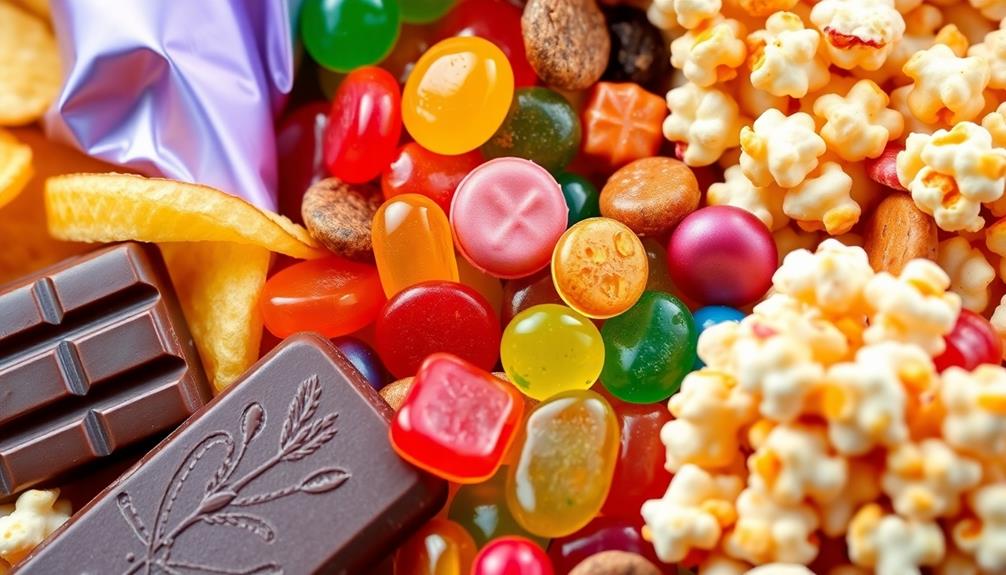Certain snacks are purposefully engineered to hit your pleasure centers hard. High sugar, fat, and salt levels activate reward pathways in your brain, much like addictive drugs do, making it tough to resist cravings. These snacks can trigger compulsive eating behaviors by enhancing their flavor and texture, creating a cycle that's hard to break. Genetic factors and emotional triggers play significant roles, too. As you reach for that bag of chips or cookies, you're not just indulging; your brain chemistry is pulling you in. Understanding these factors can help you make better choices and regain control. Stay tuned for more insights.
Key Takeaways
- High-fat, high-sugar snacks trigger dopamine release, activating brain reward pathways similar to addictive drugs and reinforcing cravings.
- Processed food companies engineer flavors and textures to maximize sensory appeal, leading to compulsive eating behaviors.
- Ultraprocessed snacks create a cycle of cravings through their combination of sweet and savory flavors, increasing the likelihood of overeating.
- Genetic predispositions, such as variations in the dopamine D2 receptor gene, can enhance susceptibility to food addiction and cravings.
- Emotional and environmental factors significantly influence cravings, making it challenging to resist high-calorie snack consumption.
Overview of Food Addiction
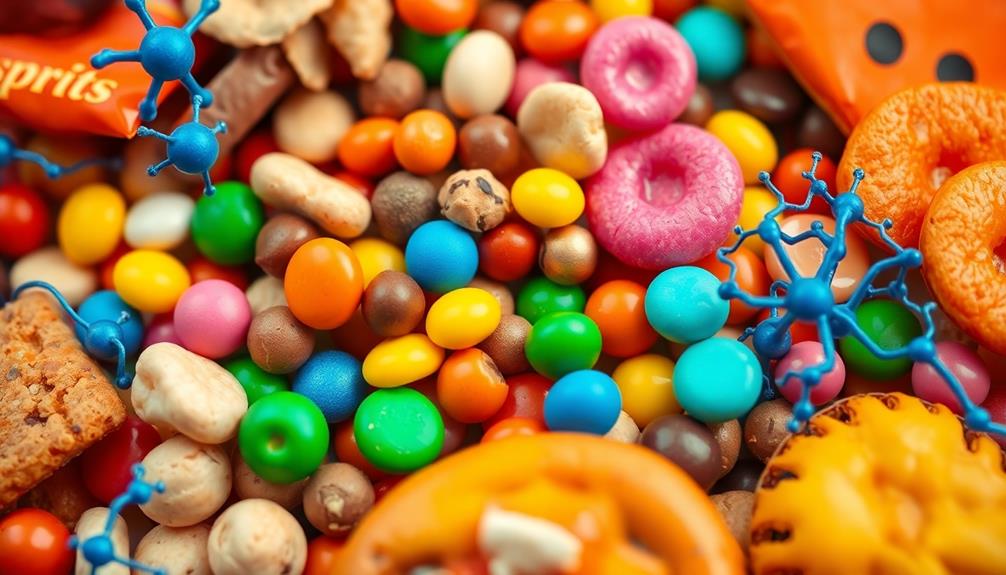
When it comes to food addiction, you might be surprised to learn that it shares many characteristics with substance abuse disorders. You may notice intense cravings and a loss of control, leading to binge eating behaviors that can feel overwhelming.
Researchers have identified that palatable foods, especially those high in fat and sugar, can trigger brain reward centers similarly to illicit drugs. This activation leads to the release of neurotransmitters like dopamine, driving your cravings and seeking behaviors. Notably, traditional dishes like Red-Braised Pork Belly exemplify how rich flavors and textures can enhance cravings and contribute to addictive eating patterns.
To help identify food addiction, the Yale Food Addiction Scale (YFAS) has been developed. However, it's essential to recognize that this scale might capture disordered eating behaviors rather than true addiction.
Studies reveal that around 20% of adults exhibit food addiction behaviors, and many experience withdrawal-like symptoms when they try to abstain from highly processed foods. Emotional and environmental factors—like stress and social influences—play a significant role in food addiction, highlighting its complex nature.
Understanding these elements can help you recognize and address your relationship with food, allowing you to make healthier choices.
Addictive Food Characteristics
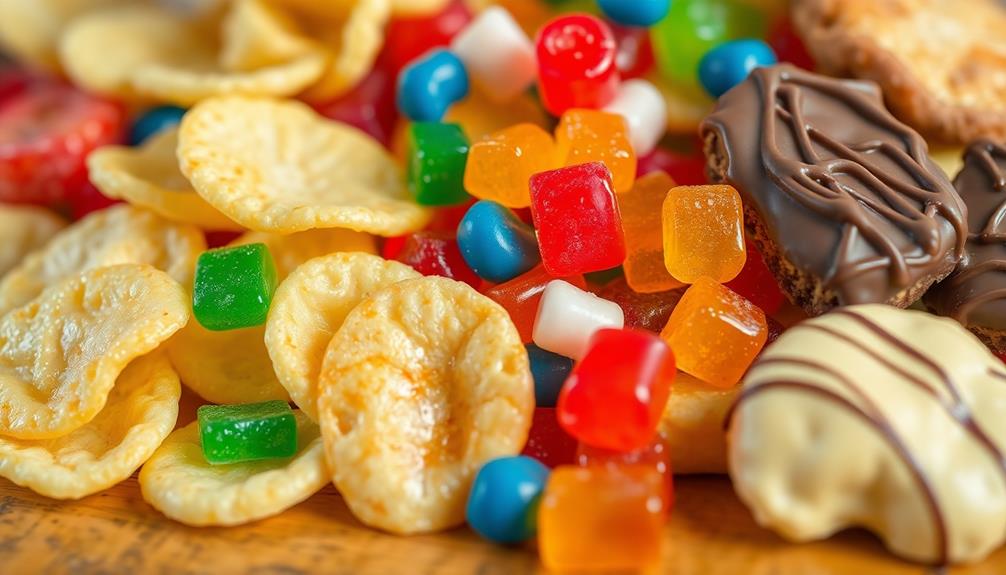
When you snack on foods loaded with sugar, fat, and salt, you're not just enjoying a treat; you're experiencing a carefully engineered product designed to keep you coming back for more.
Processed food companies use specific techniques to enhance flavors and textures, making it hard to resist their creations. For instance, the irresistible combination of sweet and savory can lead to cravings similar to those experienced during holiday feasts, where Turkey Sandwich (For Leftovers) or other comforting dishes often play a role in indulgence.
This combination of high-calorie ingredients can trigger cravings that feel almost impossible to control.
High-Calorie Food Combinations
Often, people find themselves reaching for snacks that combine high levels of fat and sugar, unknowingly engaging in a cycle of cravings. These high-calorie food combinations are engineered to trigger your brain's reward system, making them irresistibly appealing.
For instance, festive treats like Graveyard Taco Dip and Spooky Spider Pizzas can exemplify how layered flavors and textures contribute to their addictive nature. When you indulge in processed foods like chocolate, ice cream, or pizza, the mixture of sugar and fat creates a palatable experience that's hard to resist.
Research shows that around 20% of adults exhibit addictive behaviors related to food, particularly when it comes to these tempting snacks. The sensory appeal of ultraprocessed snacks, which are specifically designed to maximize flavor and texture, can lead to stronger cravings and overeating patterns.
You might find yourself reaching for another slice of pizza or another scoop of ice cream, even when you're not particularly hungry.
This cycle isn't just about taste; it's about how these combinations interact with your brain. They stimulate your reward system more effectively than single-ingredient foods, leading you to seek them out repeatedly.
Recognizing the addictive nature of high-calorie food combinations can help you make more mindful choices in your snacking habits.
Processed Food Engineering Techniques
Processed food engineering techniques focus on creating snacks that aren't just enjoyable but also addictive. You mightn't realize it, but companies often engineer highly processed foods by combining high levels of sugar and fat. This combination greatly enhances the snacks' palatability and craving potential, making them far more addictive than natural alternatives.
For example, the festive appeal of snacks like Graveyard Taco Dip showcases how presentation can enhance desire while also delivering strong flavors.
Flavor enhancers and additives create irresistible sensory experiences, leading you to consume more and develop habitual overeating behaviors. These ultraprocessed foods are specifically formulated to maximize taste, texture, and mouthfeel, triggering stronger reward responses in your brain than single-ingredient foods.
When you indulge in sweet, salty, and fatty flavors, it can lead to compulsive eating behaviors similar to those seen in substance abuse disorders.
The development process for these addictive snacks involves extensive consumer testing to refine flavors and textures that incite cravings. This highlights the industry's keen focus on understanding your food behaviors and preferences.
Ultimately, processed food engineering techniques are designed to engage your pleasure centers, making it hard to resist reaching for that next bite.
Biological Mechanisms of Addiction
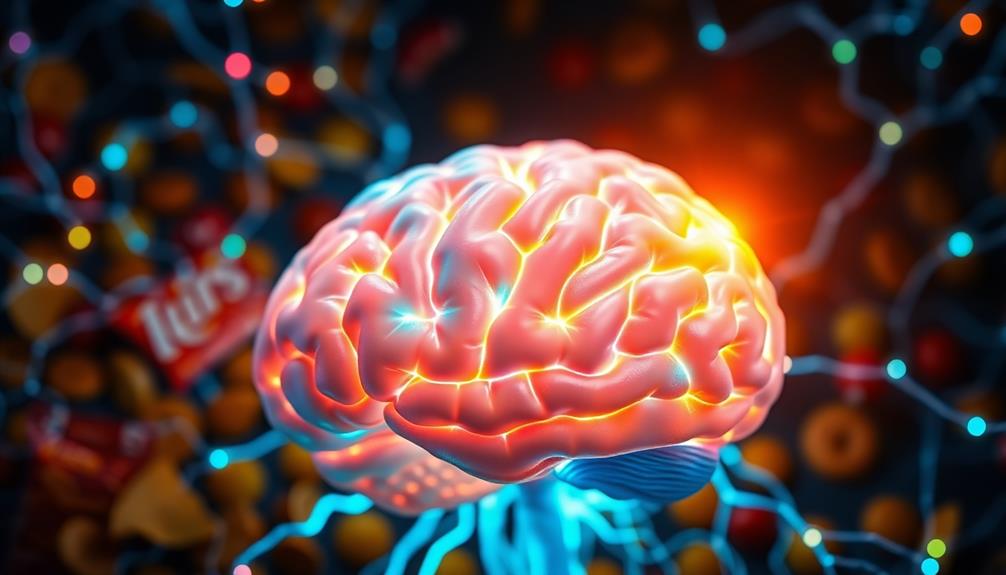
When you indulge in high-fat, high-sugar snacks, your brain's reward pathways kick into high gear, triggering a surge of dopamine. This response can mirror the effects of addictive drugs, making it hard to resist reaching for more.
For example, foods like loaded baked potatoes and chicken wings can be particularly enticing due to their rich flavors and comforting textures.
Plus, your genetic makeup might influence how easily you become hooked on these tasty treats.
Brain Reward Pathways
The brain's reward pathways play an essential role in how you experience cravings for certain snacks, particularly those high in fat and sugar. When you consume these snacks, your brain processes are activated, triggering the release of dopamine, a neurotransmitter linked to pleasure and reward. This response can be so strong that it mimics the effects of substance use disorder, reinforcing your desire for these indulgent foods.
Interestingly, traditional Brazilian desserts, such as Brigadeiro, are often high in sugar and fat, which can amplify these cravings. Several factors contribute to this phenomenon:
- Palatability: High-fat, high-sugar snacks activate reward centers more efficiently than single-ingredient foods, leading to heightened cravings.
- Genetic predisposition: Variations in dopamine receptor genes may affect your sensitivity to rewards, increasing your cravings for these snacks.
- Incentive sensitization: Repeated exposure to palatable snacks enhances cravings based on pleasure rather than genuine hunger, making it tough to resist.
Food companies often engineer their products to maximize these effects, making it even harder for you to say no.
Understanding these brain reward pathways can help you navigate your cravings and make healthier choices.
Dopamine Release Mechanism
Understanding how dopamine release works is essential to grasping the addictive nature of certain snacks. When you indulge in high-fat and high-sugar treats, your brain responds by releasing dopamine, the neurotransmitter linked to pleasure and reward. This surge activates the brain's reward centers more effectively than less appealing foods, reinforcing your cravings for those specific snacks.
Curiously, just as Farm-to-Table Cooking emphasizes the nutritional benefits of whole foods, the lack of nutrient-dense options in many processed snacks can exacerbate this cycle of addiction. As you enjoy these palatable foods, the dopamine release intensifies your desire, leading to compulsive eating behaviors akin to those seen in substance abuse disorders.
Research shows that these cravings trigger similar brain regions as drugs do, suggesting that the addictive potential of certain snacks is significant. The more you expose yourself to high-fat options, the more you may find your preference for healthier foods dwindling.
This alteration in brain reward pathways can influence your dietary choices, making it challenging to resist those irresistible snacks. So, the next time you reach for that bag of chips or a sugary treat, remember—it's not just your willpower at play; it's your brain's chemistry driving those cravings.
Genetic Predisposition Factors
Genetic predisposition plays an essential role in determining how susceptible you're to food addiction. Certain genetic factors can influence your brain's reward processing, making you more vulnerable to becoming addicted to food, especially those high in fat and sugar.
For instance, traditional dishes like Muamba De Galinha often incorporate rich flavors and high-fat ingredients, which may trigger cravings due to these biological mechanisms.
Here are three key ways this predisposition manifests:
- Dopamine Regulation: Variations in the dopamine D2 receptor gene (DRD2) are linked to lower receptor availability, which might make you crave foods that provide quick pleasure.
- Family History: If you have a family history of substance use disorders, you may share genetic traits that heighten your sensitivity to food rewards, increasing the likelihood that you'll develop addictive eating behaviors.
- Opioid System Interaction: Specific genetic alleles can amplify the pleasurable effects of high-fat foods, leading to stronger cravings and a tendency to indulge more frequently.
These genetic predispositions can interact with environmental factors, like the availability of highly palatable snacks, making it even harder to resist the urge to overeat.
Understanding these biological mechanisms can help you make informed choices about your diet and lifestyle.
Health Risks of Overeating

Overeating, especially when it comes to ultraprocessed snacks, poses significant health risks that can't be ignored. You mightn't realize it, but indulging in these high-calorie treats can lead to obesity, which affects over 40% of American adults. The more you engage in addictive eating behaviors, the higher your risk of developing chronic diseases like diabetes and heart disease.
In fact, studies show that consistently overeating can increase your mortality risk by 25%. Additionally, consuming rich dishes like Mushroom Masala or other Indian meals regularly could contribute to these unhealthy eating patterns if portion sizes aren't managed properly.
Not only does overeating affect your physical health, but it also impacts your mental well-being. Emotional and binge eating often results in feelings of guilt and shame, which can create a vicious cycle of unhealthy eating patterns.
When you consume these addictive snacks regularly, your brain's reward circuitry gets altered, leading to increased cravings that are hard to resist.
Additionally, overeating can result in insulin resistance and metabolic syndrome, setting the stage for type 2 diabetes. Understanding these health risks is essential for making informed choices about your snacking habits and recognizing when it's time to seek help.
Strategies to Combat Food Addiction
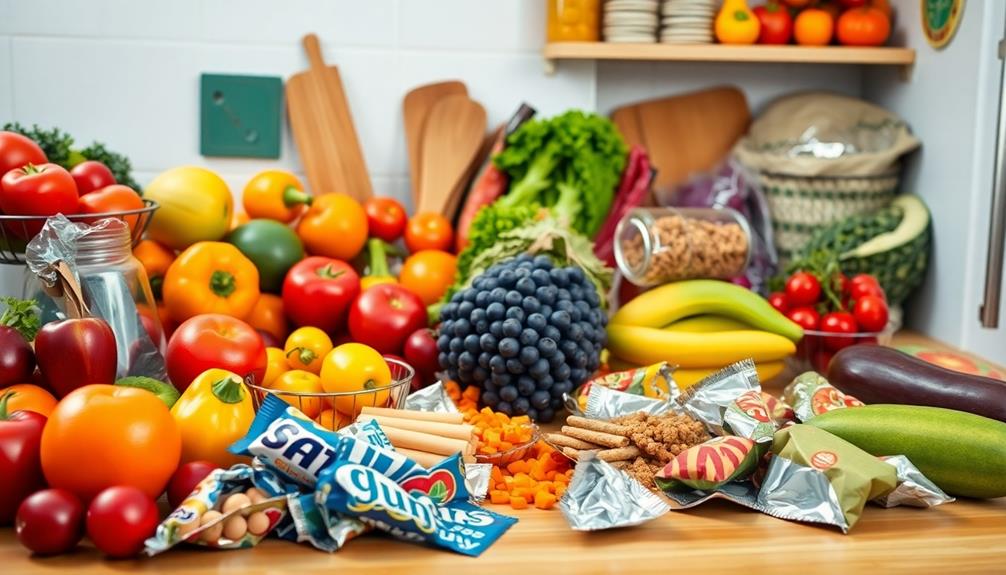
While it may feel overwhelming at times, there are effective strategies you can implement to combat food addiction and regain control over your eating habits. By making some key lifestyle changes, you can improve your eating behaviors and support weight loss. Incorporating diverse and wholesome options, such as traditional Ethiopian dishes like Yeselata (Ethiopian Salad), can provide a rejuvenating and nutritious alternative to processed snacks.
- Seek Professional Help: Consulting with registered dietitians or psychologists can provide you with tailored strategies to manage your food addiction effectively. They can help you understand your triggers and develop a personalized plan.
- Modify Your Environment: Remove unhealthy snacks from your home and keep them out of sight. This simple change can considerably reduce cravings and impulsive eating behaviors.
- Practice Mindful Eating: Focus on portion control and listen to your hunger cues. By practicing mindful eating techniques, you'll become more aware of your food intake and prevent overeating.
Incorporating regular physical activity into your routine can also help improve your mood and reduce stress, further mitigating cravings for comfort foods.
Gradually shifting to a balanced diet filled with whole, nutritious foods can decrease the likelihood of addictive eating behaviors associated with highly processed snacks.
Psychological and Social Influences

Understanding the psychological and social influences on your eating habits can be vital in managing food addiction. Psychological factors, like emotional eating, often drive you to seek comfort in high-fat and high-sugar snacks, especially during stressful times.
When anxiety hits, those cravings can feel overwhelming, leading you to indulge in unhealthy choices as a coping mechanism.
Social influences also play a significant role in your dietary preferences. Cultural norms and peer behaviors shape what you eat, often increasing your consumption of addictive snacks in social gatherings.
You might find yourself snacking more just because others are doing the same.
Moreover, mindless eating exacerbates these issues. When distractions, like watching TV or scrolling through your phone, pull your attention away from your food, you may lose track of how much you're consuming.
This can lead to overeating and reinforce those addictive behaviors.
Frequently Asked Questions
What Is the Science Behind Addictive Foods?
Addictive foods trigger your brain's reward system, combining sugar, fat, and salt. These ingredients release dopamine, creating cravings that make you want more, often leading to overeating and difficulty resisting these tempting snacks.
What Makes Snacks so Addictive?
Snacks are like that overly charming friend who promises fun but leaves you wanting more. Their irresistible combo of sugar and fat tricks your brain into craving them, turning munching into a delightful yet dangerous habit.
What Is the Main Idea of the Extraordinary Science of Addictive Junk Food?
The main idea centers on how engineered snacks, packed with sugar, fat, and salt, trigger intense cravings and compulsive eating behaviors, reshaping your food preferences and leading to unhealthy patterns over time.
What Is the Most Addictive Snack in the World?
Imagine a siren's call, luring you closer. That's what chocolate does; its rich sweetness and creamy texture create an irresistible urge, making it one of the most addictive snacks you can't seem to resist.
Conclusion
In understanding the science behind food addiction, it's clear that certain snacks can be as irresistible as they are harmful. Remember, "you are what you eat." By recognizing the addictive qualities of these foods and the biological mechanisms at play, you can take steps to regain control. With the right strategies and awareness, you can break free from unhealthy patterns and make choices that nourish your body and mind. Don't let cravings dictate your life!
